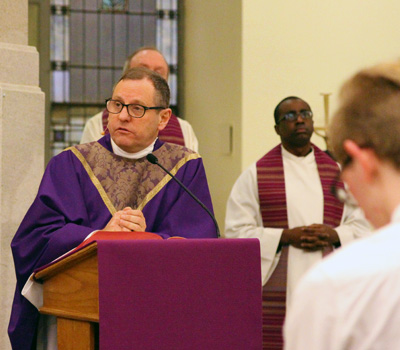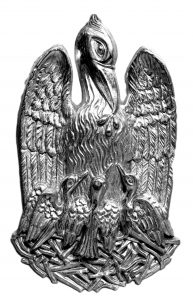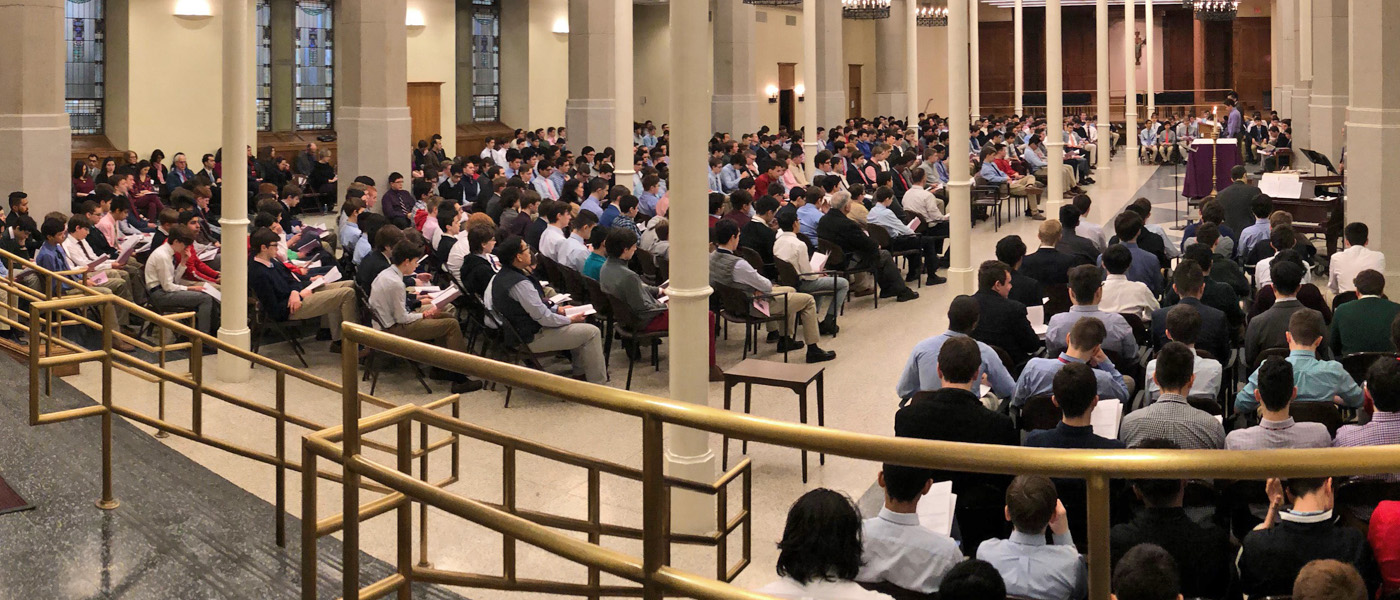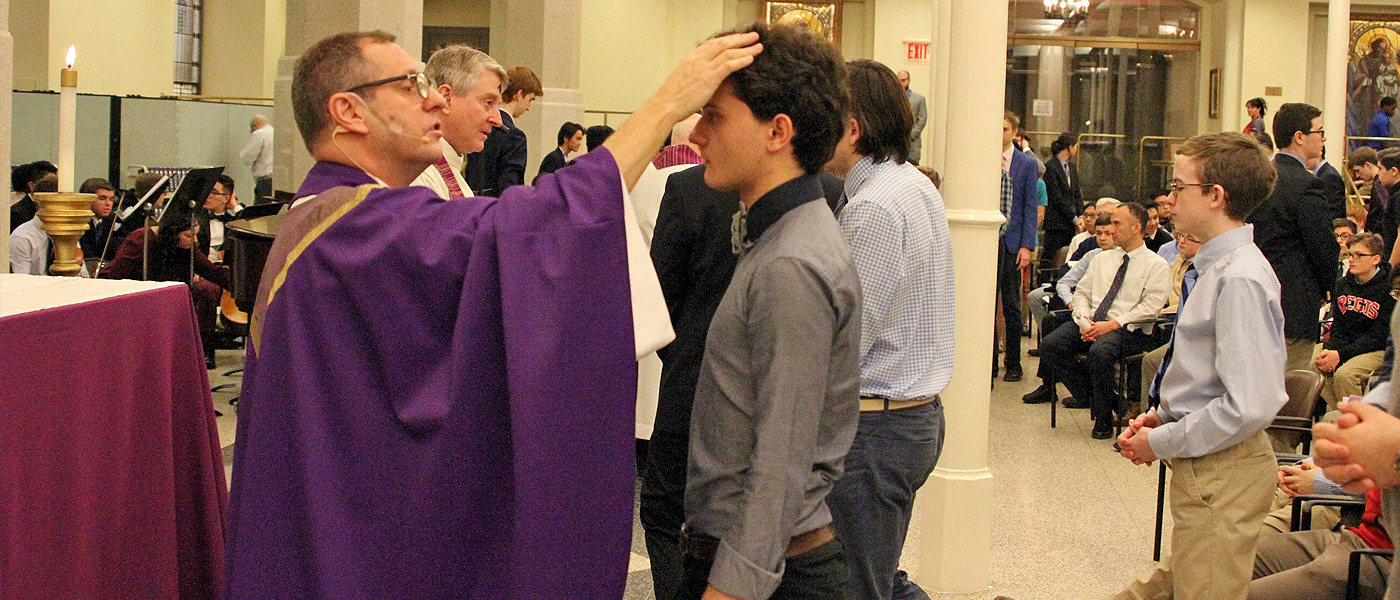Homily for Ash Wednesday 2018
On Wednesday, February 13, the Regis High School community gathered in Saint Ignatius of Loyola's Wallace Hall to celebrate Ash Wednesday and the beginning of Lent. Below is a reprint of Fr. Mark Lane, CO's homily delivered at the Mass.
I once worked in Africa. Those three months where perhaps the most formative of my life. I find myself constantly going back to them.
I took the place of a missionary priest for those three months. His parish was a portion of northern Kenya about the size of Connecticut, bordering Uganda, Southern Sudan and Ethiopia.
The parish house was in a village called Lokitaung in a valley in the hills above a salty Lake Turkana, the world’s largest desert lake.
 Before going I imagined that a desert would be a quiet and peaceful place. It was not.
Before going I imagined that a desert would be a quiet and peaceful place. It was not.
As the sun was setting a chorus of sounds would begin — dogs barking, rosters crowing, kids screaming at play — echoing up the valley, bouncing of the hard surfaces, no vegetation to muffle the sounds.
The noise was especially bad on Friday evenings when the shrieking of women was added to the chorus. After one particularly loud Friday evening I asked a local why the Turkana women were screaming.
She told me that often the mothers would come home after a long week in which each day they had little or nothing to feed their children, so they would yell at them, partly out of frustration, but mainly in an attempt to distract their children from their hunger pains. They were hoping that the kids would be so upset they would forget their hunger and go to sleep.
Other mothers had a quieter approach. They would place rocks in a pot of boiling water on the fire telling their kids to go to sleep until the meal was prepared. If the kids woke up they would gently tell them, “See, it’s still cooking. Go to sleep and I will wake you when it is ready.”
What is it like to be a mother (or father) and have nothing to offer your children? What is it like to look at the eyes of your children, children you love with all your heart, and see their hunger, and know they are totally dependent on you, and despite all your love and effort you have little, or nothing, to give them?
 On the cover of today’s program is an image.
On the cover of today’s program is an image.
The image, courtesy of Mr. Hein, is a photo of the door of the Regis chapel tabernacle.
It depicts a mother Pelican and her nesting chicks.
If you look closely you can see that the mother Pelican has pierced her chest and three drops of blood have appeared. A drop for each one of her offspring.
The image refers to a tradition that a mother Pelican would, when she had nothing else to feed her young, vuln (wound) herself to feed them with her own blood. She would give her life so that they would live.
Early Christians saw in this practice similarities with a God who in Jesus Christ poured out his own blood for the life of the world.
The earliest traces of the tradition are found in the Physiolgus, an anonymous early Christian text which likely appeared in the second century probably in Alexandria in Egypt. The text is quoted by the early Church Fathers, St. Basil among others, and became popular in the Middle Ages as a source for symbols used in various stone carvings and other works of art.
Dante in the Paradiso 25 refers to Christ as “our Pelican”. And this deep and rich relationship to the Eucharist is referenced in the Coat Arms of Corpus Christi colleges at both Oxford and Cambridge.
Shakespeare picked up the image in Hamlet. In Act 4 Scene 5, Laertes talking about his father’s true friends to Claudius declares:
To his good friends thus wide I’ll ope my arms
And, like the kind life-rendering pelican,
Repast them with my blood.
What is Lent about?
Why are we gathered here today?
Why will we all in a few minutes come forward and (ostentatiously) mark our foreheads with ashes?
I believe that we undertake this journey of 40 days so that we might call ourselves to the same noble generosity as the “kind life-rendering pelican”.
That when our time comes our hearts and minds and bodies might move towards giving of ourselves for the life of others.
Parents know this truth in the needs of their children. Lovers spontaneously want to give of themselves for the other. Friends live it naturally. Penitents – Lenten penitents in particular - consciously chose it.
What we do in Lent is stretch and train ourselves after the model of the Eucharist. The pelican is on the door of the Regis chapel tabernacle to remind us of this truth.
If the ashes on our forehead are to be more that tribal markings or a sentimental gesture, then we must aspire to this truth in the pattern of our living.
As you know, we burnt last year’s Palm Sunday palms on Monday to make our ashes today. The practice beautifully captures the truth of Lent – that it is in dying that we are born to life – out of the ashes comes life.
I must let go in order to let others in. I must give up something of my own to give to others. I must pour out some of myself to create space to receive. Jesus said it like this: “Unless the wheat grain falls to the ground and dies it will not bear fruit.”
My Lenten practices need to be ascetical. They need to be real and practical and have a cost. The discipline of Lent is a form of dying – dying to self – giving up something of my time and agenda, my needs and desires. The ascetical quality of Lent is its genius and gift.
It calls us to see the rightness and beauty of a God who gives his life so we may live. Christ our Pelican as Dante said.
In a few minutes we will receive the ashes – don’t be afraid to wear them – don’t be afraid of the generosity and indeed heroism they call you to. Don’t shy away from the love that arises in your breast to feed a hungry world.
Read more Regis news

